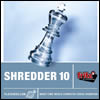


ChessBase 17 - Mega package - Edition 2024
It is the program of choice for anyone who loves the game and wants to know more about it. Start your personal success story with ChessBase and enjoy the game even more.
 Shredder
10 and the Shredderbases
Shredder
10 and the ShredderbasesNo program has won as many titles in computer chess events as Shredder, the chess program written by Stefan Meyer-Kahlen of Germany. The latest version has been substantially improved and plays about 80 Elo points stronger than its predecessor. But the author has not concentrated his attention just in making the program stronger, compared to its rivals on the market. As in the past he has also implemented features that are aimed at making Shredder a very powerful analytical tool, one that chess amateurs and experts alike can use to study chess in a more reliable and systematic way. In this article we will describe just one of them.
One of the important analytical features is the unique use by Shredder of the so-called endgame databases. Before we tell you about this it would be expedient to remind ourselves what these databases are all about.
The generation of endgame databases was pioneered by Ken Thompson, a computer scientist at the Bell Laboratories (and incidentally the inventor of Unix and one of the fathers of the computer language C). In the 80s Thompson began to generate and store all legal chess endgame positions with four and five pieces on the board. A typical five-piece ending, like king and two bishops vs king and knight, contains 121 million positions. With a pawn, which is asymmetric in its movements, the number rises to 335 million. Thompson wrote programs that generated all legal positions and worked out every forcing line that is possible in each endgame. He also compressed the resulting data in a way that allowed one to store about 20 endgames on a standard CD-ROM.

One of the first endgame database sets to be published (by ChessBase) on CD-ROM
Half a computer generation later the Russian programmer Eugene Nalimov invented a new way to store the information contained in the endgame databases, one that would allow chess programs to access it during the search. This is important, since the programs were now able to do much more than simply play certain endgames perfectly when they happened to occur on the board. Fritz, Shredder, Junior and the other chess programs could substitute whole sections of the search tree, ones generated when a three, four or five-piece endgame was encountered, by one “seek” on the hard disk, where total information on the position was available.
Naturally accessing the hard disk during a search is painfully slow (compared to processes that are executed in memory). On the other hand one read operation could replace the generation of thousands or tens of thousands of positions in the tree, a process that could in fact result in a flawed evaluation. The information gleaned from the Nalimov “tablebases” (the name he gave to his way of storing the knowledge) was, on the other hand, 100% reliable.
Today all respectable chess programs use tablebases to great effect, often announcing mates in 20 to 80 moves as the final outcome of their games. Shredder has always been at the forefront of efficient tablebase use.
In version 10 Stefan Meyer-Kahlen has introduced a brand-new and potentially very powerful improvement. He has defined a new format called “Shredderbases” that allows the program to access the tablebases thousands of times faster than was previously possible.
The method used by Shredder 10 is to compress the tablebases dramatically, so that they fit into the RAM memory available in modern computer systems. All three and four-piece endgames occupy just one megabyte in the Shredderbase format; and including all five-piece endings the sum total is 157 MB – compared to the 7500 MB required for the traditional Nalimov tablebases.

Shredder in a critical game during the World Computer Chess Championship
2006 in Turin.
Stefan Meyer-Kahlen (right) beat the program Rybka, programmed by Vas Rajlich
(left).
This means that Shredder 10 can load the entire three, four and five-piece endgames into memory and requires no hard disk activity to access them. The result is that the access times are reduced by a factor of 1000, allowing the program to consult the endgame databases much more often with hardly any delay. This gives Shredder’s playing strength and analysis capability a substantial boost in certain types of endgame.
For Deep Shredder 10 Stefan has taken the process a step further. Assuming that owners of the multiprocessor version of his program will have a lot of RAM available on their systems he has included a version of the Shredderbases that is 441 MB in size. The fact that the information in this file is not as highly compressed as in the 157 MB version means that the program can decompress it faster during the search – ten times faster in fact. You don’t need a calculator to do the match: using the 441 MB Shredderbases is ten thousand times faster than the traditional use of Nalimov tablebases by chess programs.
You can order the latest version of Shredder immediately, in the single or multi-processor version. Apart from the Shredderbases both programs include:
Shredders world championship titles
| € 49.99 (incl. VAT) | US $54.30 (without VAT) | |
| € 99.99 (incl. VAT) | US $108.61 (without VAT) |